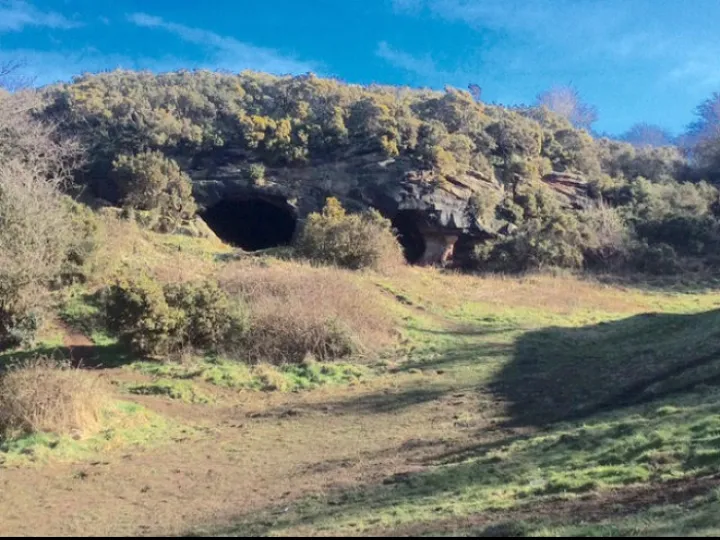A Victorian Cave-Dweller, George John Thompson (1834-1904)
This morning we bring you something from the Archives of a Victorian Cave-Dweller on The Ridge.
This interesting character who once may have been described as "a gentleman of the road", familiar to the residents of Frodsham in the late nineteenth century, is one of the more vivid characters recorded by history to be associated with the caves on the Sandstone Ridge.
"Old George Thompson" was born in Liverpool and was baptised at St Martins in the Fields on the 2nd November 1834 to middle-aged parents: John, a grocer, and mother Betsy. They were living on Scotland Road and by 1842 had moved to Dalrymple Street, Liverpool, but from 1822 they had also owned the freehold of a house on Vicarage Lane in Overton, Frodsham . John had been born in Frodsham and by 1845 he had decided to return to the house in Overton while continuing to trade as a grocer. His son would have been about 10 or 11 and the move may have been motivated by a wish to get him a good education. Indeed, in the Census of 1851 when George would have been 16 he was still listed as "Scholar". He may well have been attending the Frodsham Grammar School where English, Classics, French and Music were in the curriculum. A press cutting exists of an obituary from a 1904 paper, The Mercury, which confirms that the young George was "of a good family, possessing means. He had a good education, was a fine landscape drawer and painter, and a violin player of no mean repute". It seems, however, that for all its advantages, George's youth was not happy. The obituary added: "In early manhood his manner became morose and reticent, and he gradually contracted habits of a retiring and reclusive nature..." (Mercury, 12/11/1904)
By 1861, when he was 26, George was still living in the house on Vicarage Lane with his elderly, widowed father (74) and a 71-year-old aunt Elizabeth (or Betty), a "fund holder". They would have been fairly well-off. George's occupation was "gardener". His father died in 1865 and left all his property to George, but the estate by then was deemed to be worth under £100. By 1871, George was living alone in Overton, 36 years old, unmarried and still working as a gardener. In 1875 he was still recorded as the freehold owner of the property but, for reasons unknown, he sold the house that June. The obituary in The Mercury commented that his reclusive nature "eventually culminated in his voluntarily casting himself adrift from family, friends and civilisation". There is no Census record for him in 1881 and it can be assumed that he had already developed what the obituary called a "vagabond existence" which he led for over thirty years in the Frodsham hills. He was "relying on his own wits or the generosity of people with whom he came in contact in his daily peregrinations to eke out his precarious livelihood." (Mercury, 12/11/1904) We must assume the livelihood to have been "gardening", and that may have represented more than mere labouring, but could he also have been selling his drawings and paintings?
George reappeared in the Census of 1891, living in a shed in Netherton, a hamlet just below the hill in Frodsham. Then, in 1899, a curious incident occurred: a premature obituary appeared in the Cheshire Observer. It claimed that the death of "a well-known recluse known as old George Thompson" had occurred in Dutton Workhouse. There followed a portrait of an independent-minded eccentric, anticipating the 1904 Mercury obituary with similar details of his artistic skills, and adding:
...always shewing a disinclination to spend his days continually in the workhouse, he spent his time in roaming about the neighbourhood at all hours, day and night, winter and summer, wet or fine, assuming the utmost nonchalance as to the remarks and inquisitive glances of other pedestrians. He was generally to be noticed attired in an old worn-out coat, which almost covered him from head to foot. As for his sleeping abode, he usually retired at night into the caves on Overton or Helsby Hills. (Cheshire Observer 4/2/1899)
In fact, Old George was still alive. The report was rescinded a week later: "we are glad to hear that the old man, though very ill, is still living" (Cheshire Observer 11/2/1899). It is difficult to understand how such a mistake might have been made. It is not surprising that George might have needed to take advantage of poor relief at the workhouse and it is possible that his death was anticipated, but where did the detail and information about his artistic skills come from? It seems unlikely that an obituary would have been prepared by the newspaper in advance as is sometimes done for important celebrities. Given his apparent intelligence and independence of spirit it has been suggested that this was a cynical joke on the part of old George himself. Either that or thirty years haunting the streets of Frodsham really did make him a celebrity in the town.
George went on to live another five years. He had not been such a recluse that, living in a cave or a shed, he wasn't prepared to respond to the enumerators of the Census and in 1901 he was found living in a "Sand cave" near Chester Road, Helsby. He claimed to be aged 59 but he was closer to 67. No occupation was cited. The precise location of this cave is unknown but there were a number of caves on the side of Helsby Hill that were exploited by sand-gatherers, the largest and best preserved, being the Tweedle family's Conker Cave on Hill Road North, but there were others now lost. There is no evidence that George himself ever dug or sold the sand but sand gatherers also excavated the Overton caves which were close to his home on Vicarage Lane and would have been familiar to him from his youth, so he is likely to have been familiar with those who worked there too.
The end finally came in 1904. George died at the Runcorn Union Workhouse, Dutton, on Monday 7th November and was swiftly buried without a gravestone at Frodsham Parish Church on Wednesday 9th, aged 71. The obituary of 1899 came in handy and The Mercury leaves us with a final picture that clearly owed much of its detail to the earlier premature report:
He presented a curious spectacle slouching along, attired, as he generally was, in an old long ragged overcoat, with long unkempt beard, in all sorts of weather, impervious and oblivious to cold or wet. His life may be regarded as a wonderful exemplification of the efficacy of the open-air treatment. (Mercury, 12/11/1904).
Quite extraordinarily, the story seems to have "gone viral" and was picked up in the Southern Echo 12 Nov 1904, the Henley Advertiser 19 November 1904, the Bournemouth Echo and the South Wales Gazette! It is comforting to think that, if George had indeed written his own obituary in 1899, then he achieved some posthumous fame, and a quite disproportionate blaze of publicity, through his own efforts of intelligent manipulation of the media: the present medium and its readers included!
There may be more to learn about George and the Frodsham and Helsby caves. We know that he inhabited a cave late in his life in Helsby but The Mercury also recorded that "for years he lived in a cave or sand hole which from time immemorial has been designated by the curious sobriquet of 'Polly Parr's Kitchen', from where he migrated to another lonely cave called 'Upton's Cave'". (Mercury, 12/11/1904)
Upton's Cave (see image) is thought to be the one close to Manley Road, known today as one of the Overton or Frodsham Caves, but Polly Parr's Kitchen has yet to be identified. The Trust would be delighted to hear from anyone with any further information about these caves, about Old George Thompson himself or whether any of his paintings have survived. Please contact us via our website.
My thanks to Sue Lorimer and Mary Jones for much of the research that has contributed to this article.
Peter Winn, Trustee

Sandstone Ridge Trust
Registered Company No. 7673603
Registered Charity No. 1144470
info@sandstoneridge.org.uk

